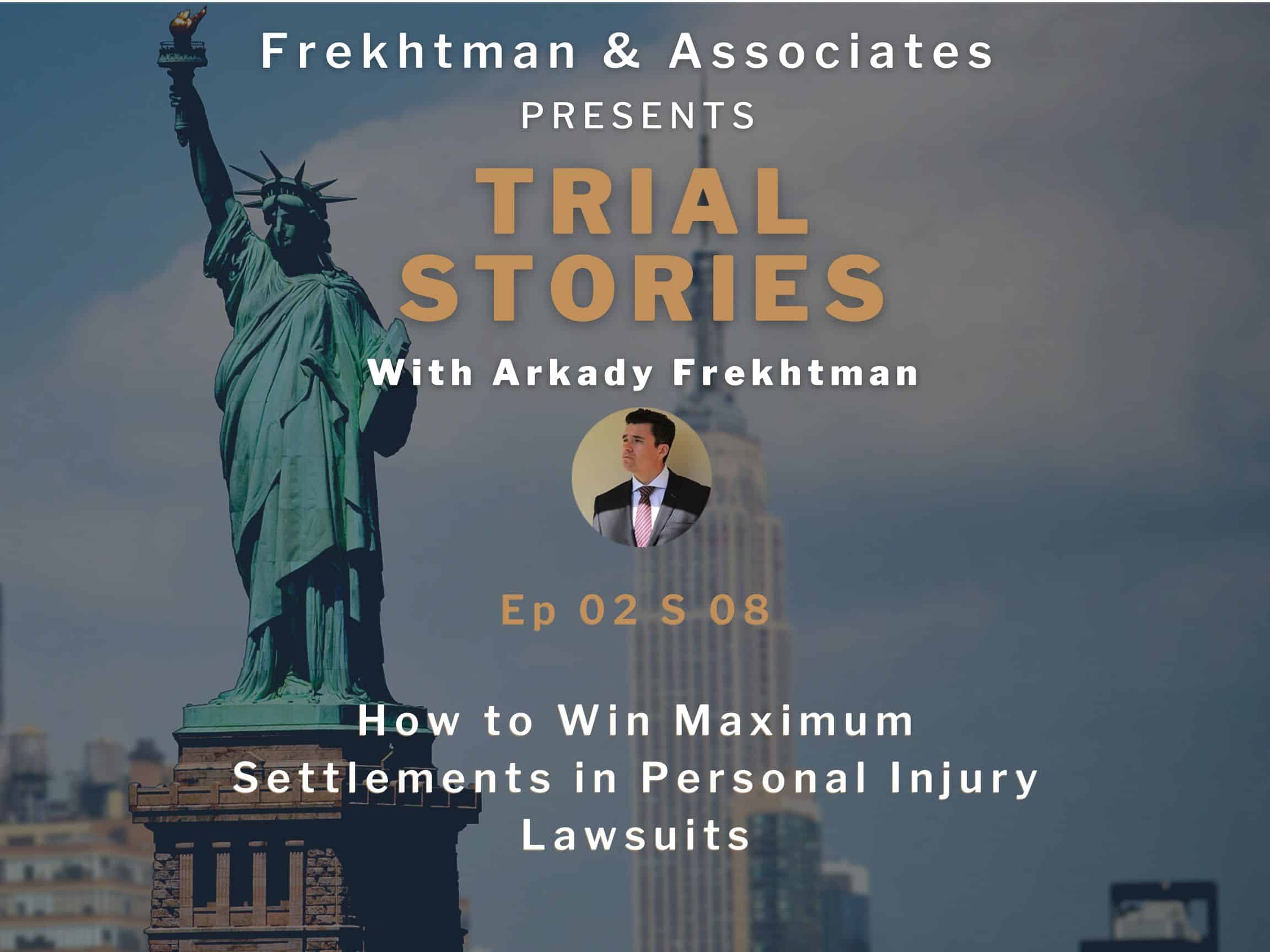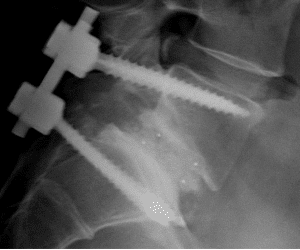EP 02 S 08: How to Win Maximum Settlements in Personal Injury Lawsuits

How to Win Maximum Settlements in Personal Injury Lawsuits, let’s talk about how to get the max value possible in personal injury lawsuit
Pick Your Favorite Channel: Apple Podcast | Google Podcasts | Spotify | Stitcher | RSS
Full Transcript
Hi, everybody. This is attorney Arkady Frekhtman in New York City, Personal Injury Trial Attorney. And today you’re in my office here in

Now, I don’t like the word demand, because to me, demand is like I’m demanding like I’m begging for a number, but I would just say, “Look, the minimum settlement amount that I would accept is $35,000.” And I would start there and I would negotiate. And I think if they would offer, let’s say $15,000 or $20,000, it’s not bad. You could settle it, because the case just isn’t really worth much more.
And when push comes to shove, would I want to go to trial on a case like that? Probably not. Probably I wouldn’t even want to go to trial, because first of all, we have a serious injury rule in New York. You could lose the case. There’s just a lot of problems, and it may not be worth it to call the doctor to come to court and pay $5,000 or $10,000 for the doctor when you have just one bulging desk with a little bit of massage and physical therapy and nothing else. It also depends on the limits. So that’s how I would handle that kind of case.
And in terms of how many back and forth, usually it’s just two or three phone calls. If I started out at $35,000 and they started out at $5,000, I would say, look, $5,000 is too low. That’s ridiculous. You got to give us something. And then they might say, okay, $10,000. And then I would say, look, I’m at $35,000. I’m not really, $10,000 is a little light. He does have that bulging disc, it’s permanent. And then they might come up to $12,000 or $15,000, and then you would probably settle it.

Well, at this point, what I would do is I would send a settlement opportunity letter, and I would say the minimum amount I would consider is $1 million and you have 30 days, you could accept this demand or you could respond to me and give me an offer in good faith. So for example, if I say a million dollars and give them 30 days, and they respond back to me and they say a million dollars is too high but we believe the case is serious, we see that your client had a fusion, we looked at all the medical records you enclosed, we looked at all the liability information, the safety experts that you enclosed, and we believe the opening offer we could make is $375,000. For example.
Okay. I would say, well, that’s something, that’s not nothing. You’re not saying $35,000, right? You’re saying $375,000. So you’re being reasonable. So let’s go to a mediation. And at the mediation, maybe we could bridge the gap and perhaps we could settle it. Maybe we could settle it for $750,000 or $850,000, and that’s fine.
Now, if they tender the million, if they offer the million that was in the letter, obviously, that’s going to satisfy it as well. And if they don’t, if they offer a ridiculous amount, like $35,000, or if they don’t say anything, then what happens is… it’s right in the letter, it’s in the letter that I send. It says if 30 days pass and you fail to give us this minimum settlement amount listed in the letter, then the new minimum amount will be like $3 million. So you have an opportunity to settle it for $1 million now, but if you don’t, that’s fine, but it’ll be $3 million.
And the only cases I do this on are cases that I want to take to trial. Cases where I feel confident that if I go before a jury, I’m going to get $3 million. Maybe I’m going to get more. But the policy limits may only be like $1 million. So I’ll say, look, I’ll take the $1 million. I’ll take your policy limit. And if they don’t offer it, then fine, then let’s go to trial. We’ll get more. It might take a little longer. And this way it’s so clear, the path is clear for me. I don’t have to worry about nickling and dining. I don’t have to worry about demanding. And then them saying, “Oh my God, you’re demanding so much. It’s not worth so much.” And wasting my time haggling.
I just make everything really clear. I give them the amount that I think it’s worth. I consult with the client, make sure the client’s on board. If they want to pay it, pay it. If they don’t want to pay it, well, if their limits are only $1 million and I said, I would take $1 million. Now, what I’ve done is I gave them an opportunity to protect their policy holder. If they say no, and I go to court, and then the jury gives me a verdict of $10 million. Well, look what they’ve done. Now, all they have is the million policy. They’re still going to give me the same million that they could have given me years ago when I wrote the letter. Except now, who’s going to pay the extra $9 million. I could argue the policy is now open, and it’s bad faith, and you failed to protect your policy holder, which is your obligation, right? There’s an obligation of good faith and fair dealing.
And an insurance company has to put their own financial interest on an equal footing with those of their policy holder. They cannot ignore their policy holder. They cannot say, “I want to make money. I’m an insurance company, and I’m just going to gamble with the policy holder.” I know that he got hit. I know my insurer was negligent. I know that he’s seriously injured, but I don’t care. I don’t want to pay a million dollars. Maybe I can go to trial, and maybe I’ll pay $300,000, and that way I’ll save $700,000, so let’s gamble.” You can’t do that as an insurance company. You’re not supposed to do that, but a lot of them do.

To answer the question, I mean, in the first instance, on the smaller case, sure. Make a demand that’s about three times what you think the case is worth and don’t be too quick to go down, because you can never go back up usually in that scenario, once you say $35,000 and then that’s it, right? It’s going to be $35,000 or less. You’re not going to get 50 now, because your initial demand was $35,000. But it’s fine if it’s a small case and you have to look at the history and the verdicts and the settlements for that injury in your locality. You have to base it on what’s been happening in your locality in the last few years.
And on the bigger cases, the cases where you could see yourself sitting with that client, taking a jury verdict. A case that is a life changing forever injury, where you believe the client, and they have a compelling human story. Sure. Go take it to trial. Those cases are great for trial and the way to do it, if you want to settle it, is write that running with the bowl type letter, the settlement opportunity letter, and say, pay me $500,000, pay me $1 million within 30 days. If you don’t, then the minimum amount is going to be like five X this amount. If it’s $1 million, it’ll be 3 million or whatever, $5 million. If it’s $500,000, fine, pay me $500,000 within 30 days by August 25th, 2022. If you do not, that’s fine, but then it won’t be $500,000 anymore, it’ll be $1 million or more.
And so, that gets the insurance companies really worried because they see their financial. They’re trying to save money. They’re for profit. They want to push you and whittle you down to nothing, and you’re flipping the script on them. You’re telling them, “Hey, pay me X, or if you don’t, great, I’m going to go for three times more.” You blow up their world. It’s like kaboom. They don’t like that. But it’s good for plaintiffs.
So I hope this has been helpful. Let us know what other questions you have about settlement or anything else. We’re here for you. Like and subscribe to our channel, and we will talk to you very soon. Okay. Have a great day, everyone. Bye-bye.
Video Version:

Contact our team at (212) 222-1111 for your free case evaluation.




